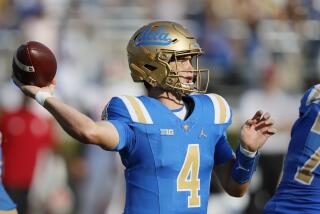SPORTING CHANCE
Southern California horse racing tracks will not exactly gallop into the 21st century. They will go about their business much as they did in the nervous 1990s, seeking new customers while trying to keep the old ones from running off.
“We’ve got to be competitive or this industry will disappear from the map,” said Cliff Goodrich, president of Santa Anita.
Other major non-team sports in the Southland, such as golf and motor racing, look forward with substantially more optimism. Tennis’ future is assured here, though there is some uncertainty over a couple of local events. And boxing has a loyal, if limited, following at several Los Angeles-area venues. All have carved their niche in the Southland sporting landscape.
The competition for Santa Anita, Hollywood Park, Del Mar, Los Alamitos and Fairplex Park is other forms of entertainment--particularly casino-type gambling on Indian reservations and further drain-off from the state lottery. Moving the market to the horseplayer, through a network of off-track betting facilities, and expanding wagering opportunities by offering out-of-state stakes races and full cards from the Northern California tracks, have not been a panacea.
In some respects, the numbers look healthy--Del Mar, offering its races to more than 1,000 out-of-state simulcast betting sites last summer, raked in a record $500 million in handle for a 43-day season--but profits at the major Southern California tracks are soft because they take on extra partners when their races are beamed to other tracks.
“The key to the future is getting our television signal into the home for betting there,” said R.D. Hubbard, chairman of the board at Hollywood Park. “This could be the salvation for racing.”
California is running behind at least seven states that already have legalized interactive betting at home.
In Kentucky, Churchill Downs, a Louisville cable company and On Demand Services (ODS), an interactive entertainment company, are offering betting to more than 1,000 homes not far from the track. This test-market operation has accounted for $8 million in betting over a 20-month period.
“The results are mixed on interactive betting, but there is a growth curve,” Goodrich said. “It’s an expensive system that will create interest and eventually help our on-track business. I’ve yet to see a sport suffer by getting a lot of exposure on television. We have to get our game into the homes, where everything else is.”
Ralph Scurfield, chairman of the California Horse Racing Board, foresees racing making a concerted effort to gain more television exposure.
“We’ve forgotten that we’re in business to entertain,” Scurfield said. “At 5 o’clock in the morning, you can see dune buggies racing on television. Somebody’s paying them to be on TV. Racing will have to use the medium to show the public what a great sport we have. The concept that the casino-hotels in Nevada and New Jersey have is the one racing needs to embrace: Offer people entertainment, and they’ll bet when they get there.”
Last August, Del Mar drew 44,000 fans, breaking its one-day attendance record by almost 10,000, when the immensely popular Cigar raced there, unsuccessfully trying to extend a 16-race winning streak.
“The problem has been the product, but the potential is there to offer more quality racing,” said Dan Smith, director of marketing and media at Del Mar. “You can’t find a Cigar every year, but that’s no reason to think that we can’t attract people with better gambling opportunities. Less can be more--fewer dates, fewer races, but larger fields.”
Santa Anita, after more than a half-century under the aegis of the Strub family, appears to be facing the future in the hands of a Massachusetts company that specializes in health-care facilities. Shareholder approval is required before a $383-million merger with Meditrust is official.
The track probably will continue to offer fewer races. In the meeting recently concluded, there was a 5% cutback in the number of races.
“It has added to the attractiveness of the product,” Goodrich said.
On the other hand, Fairplex Park in Pomona, which runs 18 days of mixed-breed racing in September in conjunction with the Los Angeles County Fair, is hoping to expand and might have a new track in a few years. Without definite financing, Fairplex plans to make a one-mile dirt oval out of its five-furlong layout and wants to add a seven-furlong turf course.
“For sure, we’ll have a state-of-the-art training facility if we can raise the money,” said Neil O’Dwyer, vice president for racing for the fair. “And in the event some racing dates open up, we’ll be positioned to apply for what’s available. There are no dates now, but both Santa Anita and Bay Meadows [south of San Francisco] have been taken over by non-racing companies, and what’s in store for them remains to be seen.”
Del Mar is a non-dividend-paying group of owners and breeders who lease the fairgrounds from the state. The Oak Tree Racing Assn., which runs an abbreviated meeting at Santa Anita each fall, is a nonprofit organization that directs its profits toward groups associated with racing.
Gary Biszantz, a prominent owner and breeder, can see the structure of the new Santa Anita changing into an operation not unlike Del Mar or Oak Tree.
“It would be the best way to go,” Biszantz said. “Give the new owners of the track several million dollars in lease money every year, and let experienced people, those closest to the game, run the place.”
More to Read
Go beyond the scoreboard
Get the latest on L.A.'s teams in the daily Sports Report newsletter.
You may occasionally receive promotional content from the Los Angeles Times.










